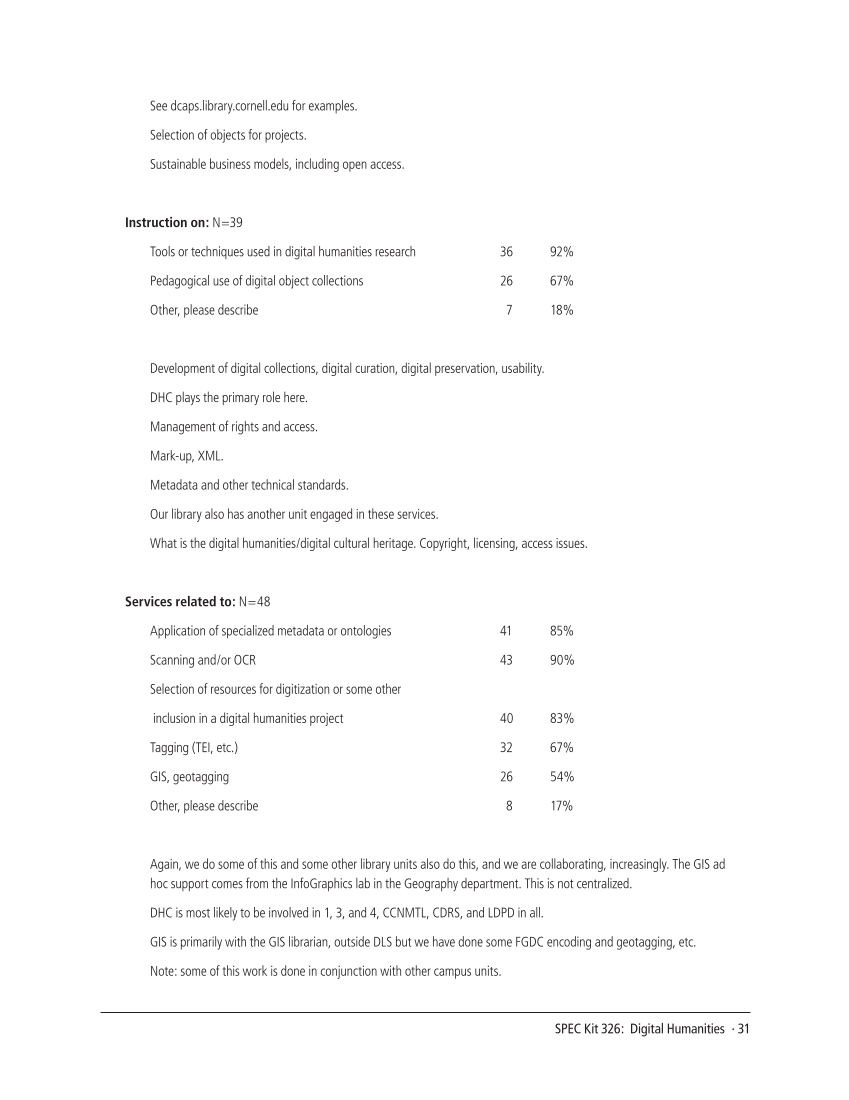SPEC Kit 326: Digital Humanities · 31
See dcaps.library.cornell.edu for examples.
Selection of objects for projects.
Sustainable business models, including open access.
Instruction on: N=39
Tools or techniques used in digital humanities research 36 92%
Pedagogical use of digital object collections 26 67%
Other, please describe 7 18%
Development of digital collections, digital curation, digital preservation, usability.
DHC plays the primary role here.
Management of rights and access.
Mark-up, XML.
Metadata and other technical standards.
Our library also has another unit engaged in these services.
What is the digital humanities/digital cultural heritage. Copyright, licensing, access issues.
Services related to: N=48
Application of specialized metadata or ontologies 41 85%
Scanning and/or OCR 43 90%
Selection of resources for digitization or some other
inclusion in a digital humanities project 40 83%
Tagging (TEI, etc.) 32 67%
GIS, geotagging 26 54%
Other, please describe 8 17%
Again, we do some of this and some other library units also do this, and we are collaborating, increasingly. The GIS ad
hoc support comes from the InfoGraphics lab in the Geography department. This is not centralized.
DHC is most likely to be involved in 1, 3, and 4, CCNMTL, CDRS, and LDPD in all.
GIS is primarily with the GIS librarian, outside DLS but we have done some FGDC encoding and geotagging, etc.
Note: some of this work is done in conjunction with other campus units.
See dcaps.library.cornell.edu for examples.
Selection of objects for projects.
Sustainable business models, including open access.
Instruction on: N=39
Tools or techniques used in digital humanities research 36 92%
Pedagogical use of digital object collections 26 67%
Other, please describe 7 18%
Development of digital collections, digital curation, digital preservation, usability.
DHC plays the primary role here.
Management of rights and access.
Mark-up, XML.
Metadata and other technical standards.
Our library also has another unit engaged in these services.
What is the digital humanities/digital cultural heritage. Copyright, licensing, access issues.
Services related to: N=48
Application of specialized metadata or ontologies 41 85%
Scanning and/or OCR 43 90%
Selection of resources for digitization or some other
inclusion in a digital humanities project 40 83%
Tagging (TEI, etc.) 32 67%
GIS, geotagging 26 54%
Other, please describe 8 17%
Again, we do some of this and some other library units also do this, and we are collaborating, increasingly. The GIS ad
hoc support comes from the InfoGraphics lab in the Geography department. This is not centralized.
DHC is most likely to be involved in 1, 3, and 4, CCNMTL, CDRS, and LDPD in all.
GIS is primarily with the GIS librarian, outside DLS but we have done some FGDC encoding and geotagging, etc.
Note: some of this work is done in conjunction with other campus units.
































































































































































































